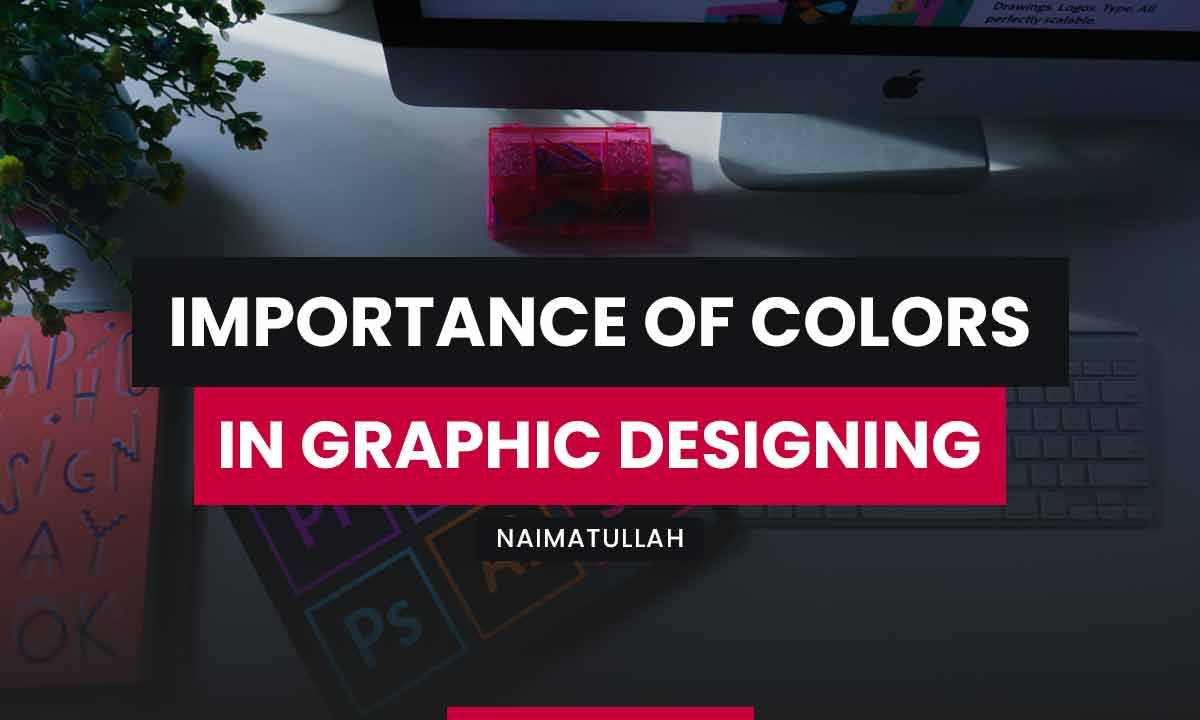Color is an essential element in graphic design. The right color palette can evoke emotions, create a mood, and communicate a message effectively. In fact, color is so vital that it can make or break a design. That’s why it’s important to understand the psychology of color and how it affects the audience’s perception of a design. In this blog, we’ll explore the importance of color in graphic design and why it should not be overlooked.
Color is the fundamental of graphic design:
it can be argued that color is one of the most important aspects of a design. Color can affect how a design is perceived, how it makes the viewer feel, and how it communicates its message. A skilled designer knows how to use color effectively to create a design that is not only visually appealing but also effective in communicating its intended message.
Graphic design, being a modern art form, employs various tools and software to create designs. These tools have made the job of designers easier, but they still require a keen eye for color and design to create an effective design. Graphic design encompasses all kinds of visual design that we perceive through our eyes, from product packaging to web design to application user interface design. In all these areas, designers have to not only create the design but also investigate how it will affect the minds of viewers.
When it comes to creating a design, designers first create a prototype of the design and then add the necessary colors to it. However, this process is not as easy as it may seem. To create a striking and effective design, designers have to spend hours thinking about the concept and how to communicate it effectively. This involves considering the color scheme and how it will impact the overall design.
In web design, application user interface design, branding, and product packaging design, having a good sense of color combination is equally as important as having good design and art skills. A well-chosen color combination can make all the difference in how the design is perceived and how it communicates its intended message.
Color theory is an important part of graphic design. It is a scientific exploration of colors and how they interact with each other. Primary colors, secondary colors, and tertiary colors are the building blocks of color theory. Additive and subtractive color models are used in different mediums to create colors. There are also different color schemes, such as monochromatic, complementary, and analogous, that can be used to create a cohesive color palette.
Finally, it’s important to note that colors evoke emotions. Each color has a psychological effect on the viewer, and designers must take this into account when creating a design. For example, blue is often associated with calmness and serenity, while red is associated with passion and excitement. By understanding how colors evoke emotions, designers can use color to create a specific mood or feeling in their designs.
Color is a Powerful Tool
Color is a powerful tool that can evoke emotions and affect our moods. It can influence our decisions, behavior, and perception of a brand. Studies have shown that people make a subconscious judgment about a product within 90 seconds of initial interaction, and about 62% to 90% of the judgment is based on color alone. In other words, color can make or break a brand’s identity.
For example, the color red is often associated with passion, love, and excitement. It’s commonly used in food industry logos such as Coca-Cola, McDonald’s, and KFC, to stimulate appetite and create a sense of urgency. On the other hand, blue is often associated with trust, reliability, and calmness. It’s commonly used in technology industry logos such as IBM, Dell, and HP, to create a sense of security and professionalism.
Color Creates a Mood
Color can also create a mood that reflects the brand’s personality and values. Different colors evoke different emotions and can influence the audience’s perception of the design. Warm colors such as red, orange, and yellow, are associated with energy, warmth, and passion. They can create a sense of excitement and urgency, and are often used to promote food, fashion, and entertainment products.
Cool colors such as blue, green, and purple, are associated with calmness, relaxation, and harmony. They can create a sense of trust and professionalism, and are often used in healthcare, technology, and financial industries. Neutral colors such as black, white, and gray, are associated with sophistication, elegance, and simplicity. They can create a sense of timelessness and professionalism, and are often used in luxury and high-end products.
Color in Graphic Design Communicates a Message
Color can also communicate a message that reflects the brand’s identity and values. The right color palette can convey a brand’s personality, story, and message effectively. For example, the color green is often associated with nature, health, and sustainability. It’s commonly used in eco-friendly products such as Whole Foods, Patagonia, and The Body Shop, to communicate the brand’s commitment to sustainability and the environment.
Similarly, the color pink is often associated with femininity, compassion, and care. It’s commonly used in healthcare industry logos such as Susan G. Komen, Breast Cancer Research Foundation, and Planned Parenthood, to communicate the brand’s commitment to women’s health and well-being.
Color Creates Contrast and Hierarchy
Color can also create contrast and hierarchy that improves readability and visual interest. The right color palette can make the design more engaging and easier to understand. For example, contrasting colors such as black and white, or red and green, can create a sense of drama and emphasize the important elements of the design.
Similarly, a hierarchy of colors can create a sense of order and guide the audience’s attention to the most important elements of the design. For example, using bright colors for the headline and muted colors for the body text can create a sense of balance and readability.
Color Enhances Brand Recognition
Color is an essential element of a brand’s identity and can enhance brand recognition. The right color palette can make a brand instantly recognizable and memorable. Consistency in color usage across all marketing materials can also reinforce the brand’s identity and create a sense of trust and familiarity with the audience.
For example, the color red is a crucial part of Coca-Cola’s branding. The bright red color is instantly recognizable and creates a sense of excitement and energy associated with the brand. The same goes for other iconic brands like McDonald’s, which uses yellow and red in its logo and marketing materials, or Facebook, which uses blue as its primary color.
Color Considerations for Accessibility
When designing for a diverse audience, color considerations should also include accessibility. People with color blindness or visual impairments may struggle to distinguish certain colors, making it difficult to understand the information presented in the design. Therefore, designers should consider using high contrast color combinations and providing alternative text or color options for those who may have difficulty seeing the colors used in the design.
How to Choose the Right Color Palette
Choosing the right color palette for a design can be a daunting task, but it doesn’t have to be. Here are some tips to help you choose the right color palette for your design:
- Consider the brand’s personality and values: The color palette should reflect the brand’s identity and values. Consider the emotions and mood you want to evoke, and choose colors that align with those goals.
- Use color psychology to your advantage: Understanding the psychology of color can help you choose the right colors to create a desired mood and communicate a message effectively.
- Consider the audience: Think about the audience’s preferences and cultural background when choosing colors. Certain colors may have different meanings in different cultures, so it’s important to do some research beforehand.
- Experiment with different combinations: Don’t be afraid to experiment with different color combinations until you find the right one. Use color palette tools and resources to help you find complementary colors and create a harmonious design.
Color can affect perception and behavior
Color can influence how people perceive and behave in certain situations. For example, using warm colors like red, orange, and yellow can create a sense of urgency or excitement, while cool colors like blue and green can have a calming effect. This is why fast food chains often use warm colors in their branding and décor to encourage customers to make quick decisions and buy more.
Color can create contrast and hierarchy
Using different colors in a design can create contrast and hierarchy, making it easier for viewers to understand and navigate the information presented. For example, using a bold, bright color for the main heading and a softer color for the subheading can create a clear visual hierarchy and guide the viewer’s eye to the most important information.
Color can communicate cultural significance
Certain colors can have cultural significance and convey meaning in different parts of the world. For example, the color red is associated with luck and prosperity in China, while in Western cultures it can be associated with danger or warning. Using color in a culturally sensitive way is important for brands that operate globally and want to avoid causing offense or confusion.
Color can enhance readability
Choosing the right color combinations can enhance readability and make text easier to read. For example, using a dark color for text on a light background can create a high contrast and make the text more legible. It’s important to consider readability when choosing colors, especially for designs that include a lot of text.
Color can create a sense of emotion and mood
Color has the power to evoke emotions and create a mood in a design. For example, using shades of blue and green can create a calming and peaceful atmosphere, while using bright, bold colors like yellow and pink can create a sense of playfulness and energy.
Color can distinguish brands in a crowded market
In a crowded market, using a unique color palette can help a brand stand out and be easily recognizable. This is why many brands choose to use colors that are not commonly used in their industry, creating a unique identity and setting themselves apart from their competitors.
Color can affect brand perception and loyalty
The colors used in a brand’s logo and marketing materials can influence how consumers perceive the brand and can even affect their loyalty. Research has shown that consumers associate certain emotions with specific colors, so using the right color palette can create a positive emotional connection with the brand and increase brand loyalty.
Color can be used to create a brand personality
Color can be used to create a brand personality and convey the brand’s values and mission. For example, a brand that values sustainability and eco-friendliness may use shades of green in their branding to convey a connection to nature and the environment.
Color can create a sense of depth and dimension
Using color can create a sense of depth and dimension in a design, making it appear more dynamic and visually interesting. By using color to create highlights and shadows, designers can add depth and dimensionality to a flat design.
Color can evoke nostalgia and memories
Certain colors can evoke nostalgia and memories, creating a powerful emotional connection with the viewer. For example, using pastel colors can create a sense of nostalgia for a bygone era, while using bright neon colors can evoke memories of the 80s.
- Color can create a sense of urgency
Using bright, bold colors can create a sense of urgency and encourage viewers to take action. This is why many brands use red in their calls to action, as it creates a sense of urgency and encourages viewers to take immediate action.
Color can create contrast and visual interest
Using contrasting colors can create visual interest and draw the viewer’s eye to important elements of the design. For example, using complementary colors, such as blue and orange, can create a striking contrast and make the design stand out.
Color can create a sense of harmony and balance
Using a harmonious color palette can create a sense of balance and harmony in a design. By using colors that are complementary or in the same color family, designers can create a cohesive and visually appealing design that is easy on the eyes
CONCLUSION:
Overall, color plays a crucial role in graphic design and should be carefully considered when creating any type of design. By understanding the psychological effects of color and how it can communicate meaning and evoke emotions, designers can create designs that are not only visually appealing but also effective in communicating a message to their audience.













